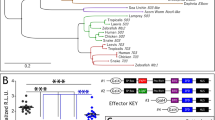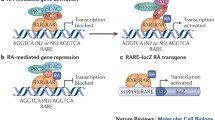Abstract
Development of the frontonasal mass (FNM), branchial arches, heart, and limbs depends on neural crest-mediated epithelial–mesenchymal (E–M) interactions. Teratogenesis by retinoic acid (RA) or blockade of serotonergic (5-HT) signaling by the pan-5-HT2 receptor antagonist, ritanserin, perturbs development of these embryonic structures. In both cases, resulting phenotypes include forebrain and olfactory placode anomalies, malformations of the face, eye and lens, as well as posterior neural tube and cardiac defects. Similar sites of malformations, together with the presence of RA response elements in the 5-HT2B receptor promoter, have led to the suggestion that a negative regulatory relationship may exist between RA and 5-HT2-mediated 5-HT signaling at sites of E–M interaction (Choi et al. 1997); however, another possibility is that RA and 5-HT act independently as opposing signals to regulate development of common embryonic targets. Together with recent evidence for opposite effects on chondrogenic differentiation in hindlimb micromass cultures (Bhasin et al. 2003a), results of the present study raise the possibility that these pathways may act as opposing signals for common targets in the mouse embryo. The RA receptors, co-factors and metabolic enzymes, and 5-HT2B receptors were found to be are coordinately expressed at sites of E–M interaction, including the FNM, in the embryonic day (E)10.5 mouse. Cell proliferation experiments using [3H]thymidine incorporation demonstrated that RA or activation of 5-HT2B receptors caused opposite effects in FNM explants, namely stimulation or inhibition of cell proliferation, respectively, 5-HT2B receptor activation did not appreciably alter patterning in FNM explants. While RA has been shown to regulate lateral patterning in the FNM (LaMantia et al. 2000), 5-HT2B receptor activation did not alter patterning in FNM explants. Quantification of 5-HT2B receptor transcripts by real-time PCR provided no evidence of negative regulation of 5-HT2B receptor expression by RA in FNM explants, although preliminary studies using in situ hybridization had suggested that this was a possibility in both explants and RA teratogenized embryos. Future studies using quantitative PCR may still show this to be the case in teratogenized embryos. Together with the finding of coordinate expression of 5-HT2B receptors and RA signaling molecules, results of the present study suggest that RA, and 5-HT mediated by 5-HT2B receptors, may act as opposing signals to regulate cell proliferation during craniofacial development in the mouse embryo.




Similar content being viewed by others
References
Anchan RM, DrakeDP, Haines CF, Gerwe EA, LaMantia A-S (1997) Disruption of local retinoid-mediated gene expression accompanies abnormal development in the mammalian olfactory pathway. J Comp Neurol 379:171–184
Bhasin N, Kernick E, Lauder JM (2003a) Differential regulation of chondrogenesis by the serotonin2B receptor and retinoic acid in the embryonic mouse hindlimb. Dev Dyn
Bhasin N, Maynard TM, Gallagher PA, LaMantia AS (2003b) Mesenchymal/epithelial regulation of retinoic acid signaling in the olfactory placode. Dev Biol 261:82–98
Bhasin N, Maynard TM, Gallagher PA, LaMantia A-S (2003c) Mesenchymal/epithelial interactions regulate retinoid signaling in the olfactory placode. Dev Biol
Blumentrath J, Neye H, Verspohl EJ (2001) Effects of retinoids and thiazolidinediones on proliferation, insulin release, insulin mRNA, GLUT 2 transporter protein and mRNA of INS-1 cells. Cell Biochem Funct 19:159–169
Buznikov GA, Shmukler YB, Lauder JM (1996) From oocyte to neuron: Do neurotransmitters function in the same way throughout development? Cell Mol Neurobiol 16:537–559
Buznikov GA, Lambert HW, Lauder JM (2001) Serotonin and serotonin-like substances as regulators of early embryogenesis and morphogenesis. Cell Tissue Res 305:177–186
Campione-Piccardo J, Craig J, Sun JJ, McBurney MW (1985) Commitment in a murine embryonal carcinoma cell line during differentiation induced by retinoic acid. Exp Cell Res 156:544–552
Choi DS, Colas JF, Kellermann O, Loric S, Launay JM, Rosay P, Maroteaux L (1994) The mouse 5-HT2B receptor: possible involvement in trophic functions of serotonin. Cell Mol Biol (Noisy-le-grand) 40:403–411
Choi D-S, Ward SJ, Messaddeq N, Launay J-M, Maroteaux L (1997) 5-HT2B receptor-mediated serotonin morphogenetic functions in mouse cranial neural crest and myocardiac cells. Development 124:1745–1755
Choi DS, Kellermann O, Richard S, Colas JF, Bolanos-Jimenez F, Tournois C, Launay JM, Maroteaux L (1998) Mouse 5-HT2B receptor-mediated serotonin trophic functions. Ann NY Acad Sci 861:67–73
Edgar VA, Sterin-Borda L, Cremaschi GA, Genaro AM (1999) Role of protein kinase C and cAMP in fluoxetine effects on human T-cell proliferation. Eur J Pharmacol 372:65–73
Fanburg BL, Lee SL (1997) A new role for an old molecule: serotonin as a mitogen. Am J Physiol Lung Cell Mol Physiol 272:L795–L806
Ferguson MW, Sharpe PM, Thomas BL, Beck F (1992) Differential expression of insulin-like growth factors I and II (IGF I and II), mRNA, peptide and binding protein 1 during mouse palate development: comparison with TGF beta peptide distribution. J Anat 181:219–238
Gustafson AL, Dencker L, Eriksson U (1993) Non-overlapping expression of CRBP I and CRABP I during pattern formation of limbs and craniofacial structures in the early mouse embryo. Development 117:451–460
Heine U, Munoz EF, Flanders KC, Ellingsworth LR, Lam HY, Thompson NL, Roberts AB, Sporn MB (1987) Role of transforming growth factor-beta in the development of the mouse embryo. J Cell Biol 105:2861–2876
Kellermann O, Tournois C, Richard S, Manivet P, Maroteaux L, Launay JM (1998) Signaling pathways and targets of the 5-HT2B receptor in the 1C11 serotonergic cell line. Ann NY Acad Sci 861:248
Kishi H, Kuroda E, Mishima HK, Yamashita U (2001) Role of TGF-beta in the retinoic acid-induced inhibition of proliferation and melanin synthesis in chick retinal pigment epithelial cells in vitro. Cell Biol Int 25:1125–1129
LaMantia A-S, Colbert MC, Linney E (1993) Retinoic acid induction and regional differentiation prefigure olfactory pathway formation in the mammalian forebrain. Neuron 10:1035–1048
LaMantia A-S, Bhasin N, Rhodes K, Heemskerk J (2000) Mesenchymal/epithelial induction mediates olfactory pathway formation. Neuron 28:411–425
Lambert HW (2000) Serotonergic regulation of insulin-like growth factor-I and cell proliferation in mouse mandibular mesenchymal cells. In: Cell and developmental biology. University of North Carolina, Chapel Hill, North Carolina, pp 126
Lambert HW, Lauder JM (1999) Serotonin receptor agonists that increase cyclic AMP positively regulate IGF-I in mouse mandibular mesenchymal cells. Dev Neurosci 21:105–112
Lambert HW, Weiss ER, Lauder JM (2001) Activation of 5-HT receptors that stimulate the adenylyl cyclase pathway positively regulates IGF-I in cultured craniofacial mesenchymal cells. Dev Neurosci 23:70–77
Lauder JM (1988) Neurotransmitters as morphogens. Prog Brain Res 73:365–387
Lauder JM (1993) Neurotransmitters as growth regulatory signals: role of receptors and second messengers. Trends Neurosci 16:233–240
Lauder JM, Wilkie MB, Wu C, Singh S (2000) Expression of 5-HT(2A), 5-HT(2B) and 5-HT(2C) receptors in the mouse embryo. Int J Dev Neurosci 18:653–662
Lee SL, Wang WW, Moore BJ, Fanburg BL (1991) Dual effects of serotonin on growth of bovine pulmonary artery smooth muscle cells in culture. Circ Res 68:1362–1368
Lee SL, Wang WW, Fanburg BL (1998) Superoxide as an intermediate signal for serotonin-induced mitogenesis. Free Radic Biol Med 24:855–858
Lee SL, Wang WW, Finlay GA, Fanburg BL (1999) Serotonin stimulates mitogen-activated protein kinase activity through the formation of superoxide anion. Am J Physiol Lung Cell Mol Physiol 21:L282–L291
Lehnert SA, Akhurst RJ (1988) Embryonic expression pattern of TGF beta type-1 RNA suggests both paracrine and autocrine mechanisms of action. Development 104:263–273
Loric S, Maroteaux L, Kellermann O, Launay JM (1995) Functional serotonin-2B receptors are expressed by a teratocarcinoma-derived cell line during serotoninergic differentiation. Mol Pharmacol 47:458–466
Merzak A, Koochekpour S, Fillion MP, Fillion G, Pilkington GJ (1996) Expression of serotonin receptors in human fetal astrocytes and glioma cell lines: a possible role in glioma cell proliferation and migration. Brain Res Mol Brain Res 41:1–7
Moiseiwitsch JR (2000) The role of serotonin and neurotransmitters during craniofacial development. Crit Rev Oral Biol Med 11:230–239
Moiseiwitsch JR, Lauder JM (1995) Serotonin regulates mouse cranial neural crest migration. Proc Natl Acad Sci USA 92:7182–7186
Moiseiwitsch JR, Lauder JM (1997) Regulation of gene expression in cultured embryonic mouse mandibular mesenchyme by serotonin antagonists. Anat Embryol (Berl) 195:71–78
Moiseiwitsch JR, Raymond JR, Tamir H, Lauder JM (1998) Regulation by serotonin of tooth-germ morphogenesis and gene expression in mouse mandibular explant cultures. Arch Oral Biol 43:789–800
Moiseiwitsch JRD, Lambert HW, Lauder JM (2001) Roles for serotonin in non-neural embryonic development. In: Gramsbergen A (ed) Handbook of brain and behavior in human development.Kluwer, London, pp 139–152
Nebigil C, Choi D-S, Launay J-M, Maroteaux L (1998) Mouse 5-HT2B receptors mediate serotonin embryonic functions. Fourth IUPHAR Satellite Symposium on Serotonin, 23–25 July
Nebigil CG, Launay J-M, Hickel P, Tournois C, Maroteaux L (2000) 5-hydroxytryptamine 2B receptor regulated cell-cyle progression: xross-talk with tyrosine kinase pathways. Proc Natl Acad Sci USA 97:2591–2596
Niederreither K, Subbarayan V, Dolle P, Chambon P (1999) Embryonic retinoic acid synthesis is essential for early mouse post-implantation development [see comments]. Nat Genet 21:444–448
Niederreither K, Vermot J, Fraulob V, Chambon P, Dolle P (2002) Retinaldehyde dehydrogenase 2 (RALDH2)-independent patterns of retinoic acid synthesis in the mouse embryo. Proc Natl Acad Sci USA 99:16111–16116
Pakala R, Radcliffe JD, Benedict CR (1999) Serotonin-induced endothelial cell proliferation is blocked by omega-3 fatty acids. Prostaglandins Leukot Essent Fatty Acids 60:115–123
Pizzinat N, Girolami JP, Parini A, Pecher C, Ordener C (1999) Serotonin metabolism in rat mesangial cells: involvement of a serotonin transporter and monoamine oxidase A. Kidney Int 56:1391–1399
Salvarezza SB, Rovasio RA (1997) Exogenous retinoic acid decreases in vivo and in vitro proliferative activity during the early migratory stage of neural crest cells. Cell Prolif 30:71–80
Shuey D, Sadler T, Lauder J (1992) Serotonin as a regulator of craniofacial morphogenesis: site specific malformations following exposure to serotonin uptake inhibitors. Teratology 46:367–378
Shuey D, Sadler T, Tamir H, Lauder J (1993) Serotonin and morphogenesis: transient expression of serotonin uptake and binding protein during craniofacial morphogenesis in the mouse. Anat Embryol 187:75–85
Stemple DL, Anderson DJ (1992) Isolation of a stem cell for neurons and glia from the mammalian neural crest. Cell 71:973–985
Takuwa N, Ganz M, Takuwa Y, Sterzel RB, Rasmussen H (1989) Studies of the mitogenic effect of serotonin in rat renal mesangial cells. Am J Physiol 257:F431–439
Weiss ER, Maness P, Lauder JM (1998) Why do neurotransmitters act like growth factors? Perspect Dev Neurobiol 5:323–335
Yavarone MS, Shuey DL, Sadler TW, Lauder JM (1993) Serotonin uptake in the ectoplacental cone and placenta of the mouse. Placenta 14:149–161
Zouboulis CC, Korge B, Akamatsu H, Xia LQ, Schiller S, Gollnick H, Orfanos CE (1991) Effects of 13-cis-retinoic acid, all-trans-retinoic acid, and acitretin on the proliferation, lipid synthesis and keratin expression of cultured human sebocytes in vitro. J Invest Dermatol 96:792–797
Acknowledgements
We thank K. Strand and T. Hartney for technical assistance. T. Maynard, E. Weiss, T. Sadler, T. Magnuson, and V. Bautch provided helpful advice and discussions during the course of this study. This work was supported by NIDCR grant DE13314 to J.M.L and NICHD grant HD29178 to A.-S. L.
Author information
Authors and Affiliations
Corresponding author
Rights and permissions
About this article
Cite this article
Bhasin, N., LaMantia, AS. & Lauder, J.M. Opposing regulation of cell proliferation by retinoic acid and the serotonin2B receptor in the mouse frontonasal mass. Anat Embryol 208, 135–143 (2004). https://doi.org/10.1007/s00429-004-0380-7
Accepted:
Published:
Issue Date:
DOI: https://doi.org/10.1007/s00429-004-0380-7




